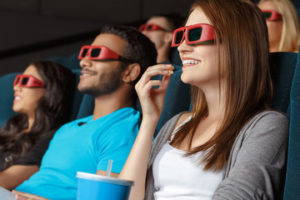How Technological Advances Affect your Eyes

3D movies continue to be popular today, but not for everyone. If you have noticed that you become dizzy or nausea while wearing the special glasses required for such flicks, there isn’t much enjoyment going on. Have you wondered why this might be happening? We’ve found out, and we’ll clue you in.
Unnaturally Natural
Our eyes are designed to observe a 3-dimensional world. Because they are spaced a few inches apart, each eye has its view, its perspective. Try it out! See how your environment looks when you observe through only one open eye. Now close that eye and observe the view from your other eye. Slightly different, right? So, naturally, these two views overlap, which is what creates clarity and dimension. Well, the 3D motion picture attempts to mimic this natural function.
How it Works
It’s amazing how far we have come in our ability to manufacture experiences. A 3D movie is made possible by a special filming process that uses two cameras. These lenses sit as our eyes do – a few inches apart. The images that are captured, then, are slightly overlapped, just like our real world. Only because our eyes do this on their own, we will not be able to clearly observe the manufactured 3D view without the help of polarized glasses that filter colors, altering our perception of what we see.
Why it doesn’t Work for Everyone
Ok, now to the important question. Why does 3D affect some people in an unintended way? It comes down to your eyes, and a little thing called binocular vision. We all have binocular vision; this just means that our eyes are both “on,” and the brain is processing information as it should. In approximately 30% of the population, both eyes are not on at the same time, which means the brain will accept certain information and reject other.
Slight inaccuracy in binocular vision typically does not pose a problem – at least outside of the 3D theater. However, there is no reason not to schedule a thorough eye exam to ensure optimal eye health! We’re happy to speak with you! Call 713-668-7337.
Category:

 CONNECT
CONNECT
Leave a Reply